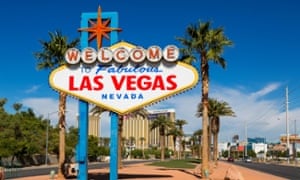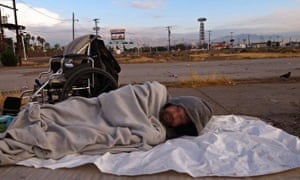Results 1 to 1 of 1
Thread Information
Users Browsing this Thread
There are currently 1 users browsing this thread. (0 members and 1 guests)
-
06-05-2015, 11:03 AM #1
'Anything that pays a paycheck': getting by in Las Vegas
Las Vegas is packed with illegals.
'Anything that pays a paycheck': getting by in Las Vegas amid slow jobs recovery
Nevada’s biggest city has the country’s highest unemployment rate but where some see steady improvement, low wages and food banks tell another story

Despite signs of recovery the unemployment rate in Las Vegas remains stubbornly high. Photograph: Alamy
Jana Kasperkevic
in Las Vegas
Friday 5 June 201510.21 EDT
Eight miles north of the Las Vegas’s famous strip, a group of locals gathered late last month in search of the ultimate prize: a job.
Analysis Behind Las Vegas glitz and glamour lies a dark city marred by poverty
Effects of the recession are still being felt in Las Vegas where the poverty rate has doubled since 2010 according to a report by the Annie E. Casey Foundation
Many of them were newly unemployed and in a need of a little luck. Of all major US cities, Las Vegas has the highest unemployment rate. In 2008, thanks to the recession, the city fell deeper and harder than the rest of America. Vegas continues to suffer but those who showed up for the jobs fair found that the odds were in their favor. Job seekers outnumbered recruiters and there were more openings than applicants.
But while the number of jobs available is rising, Vegas residents are still struggling to find full-time work and decent wages. Their struggle is likely to come into sharper focus in the months ahead. Nevada is a key battleground state for the 2016 election.
“Our unemployment rate remains fairly high. The Nevada unemployment at its worst was 14% and the Las Vegas unemployment rate was 14.4%,” Stephen Brown, director of the University of Nevada Las Vegas’s center for business and economic research, told the Guardian. “Our unemployment numbers are not back yet to where they were in 2008. The US economy began to see employment gains in 2010, but we continued to see losses.”
Overall, the economic situation in the US is looking up. The US unemployment rate dropped to 5.4% in April – the lowest since 2008. Jobless claims have slipped down to 264,000 with the four-week average of 271,750 – the lowest in 15 years.
Yet Las Vegas, which to many is synonymous with glamor, winning money or losing it, is still struggling with the legacy of the recession. At 7.2%, Las Vegas has the highest unemployment rate of any US city with population of one million or more. Nevada has an unemployment rate of 7.1%.
The Silver State is expected to keep digging itself out of the hole – with 45,000 additional jobs created in 2015, 52,000 in 2016 and 60,000 in 2017. Slow and steady wins the race, according to the state’s officials.
“The underlying trend of steady, broad-based, and sustainable growth is far more encouraging than an employment spike in a single month,” said Bill Anderson, chief economist for Nevada’s department of employment, training and rehabilitation.
A homeless man sleeps at an encampment for the homeless along Las Vegas Boulevard on 21 October 2010 in Las Vegas, Nevada. Photograph: Spencer Platt/Getty Images
That Thursday, 22 May, the recruiters who lined the floor of the sprawling gym inside the East Las Vegas community center outnumbered those looking to find a job. As lunch approached and the job fair transitioned from being veterans-only to being open to the public, recruiters eyed all possible applicants.
“It’s light, but we’re hopeful,” Ace Fair, vice-president of Fair Solutions and executive director of Legal Shield, told the Guardian. Fair was looking to hire 10 people, mainly to help with the identity theft protection part of his businesses.
A few folding tables down was Tommi Bryan from Tronox factory, which is based in Henderson, just south of Las Vegas. Bryan was hoping to hire three more people to round out the number of the employees at the factory from 97 to 100.
The company has had a hard time attracting women, said Bryan, something she blamed on workers often ending their shift covered in black residue from the manganese dioxide used to make alkaline batteries. “But it washes off,” she pointed out.
One attendee, Debbie Swartz, said she didn’t mind getting dirty. “I am looking for anything that pays the bills,” said Swartz, 57. “I’ve done a little bit of everything – retail, digging ditches, whatever it takes. I have done it all. Room reservations for the casinos. I have done call centers. Anything that pays a paycheck.”
Up until mid-May, Swartz had spent the last five years working as a Walmart cashier. A new management took over her store and due to a difference in opinion, she was let go. “I have no ill will towards them, they have no ill will towards me,” she said.
Deborah Beccar, too, has only recently become unemployed after she lost her job as an admission representative for one of Las Vegas’s for-profit schools. Unlike Swartz, who has lived in Vegas for more than 20 years, Beccar had only just moved here a couple of months ago. This was her third job fair.
Of the 1.28 million employed people in the Las Vegas area, known as Clark County, about 986,000 are full-time workers and 297,000 are part-time workers. Not only is quarter of the workforce working part-time, but the wages remain stagnant.
“Wages haven’t grown in a number of years,” said Brown. “Some lower-income people are still being hit by reduced working hours. That’s something that’s actually true up into the middle class here in Las Vegas.”
Years of high unemployment and reduced hours have caused many people living near Las Vegas to dip into their savings. Long gone are retirement funds, savings to be used for the kids’ tuition and a rainy day, according to Jodi Tyson, government affairs director at Three Square food bank.
“Even though people are coming back to work, they are making on average less in annual salary than they were making before or maybe they are not even full-time. They are only finding part-time work,” said Tyson. “It’s going to take years for those folks to be able to recover that gross asset loss.”
As a result, those who used to be middle class are now living from paycheck to paycheck.
“You have a lot of people here who for a few months they are doing fine, they are employed, then all of a sudden their car breaks down,” explained Tyson. “They can’t get to work or they need to spend the money they would be spending on food and electricity to pay for their car repair. Then they come back to the pantry.”
Analysis Guardian readers: US middle class is 'living from one crisis to the next'
Despite endless chatter of an American middle class, a precise definition of the term remains elusive. So we asked our readers to tell us in their own words where they think they fall on the US class spectrum and why
Even with improving unemployment numbers, the need for food pantry services has not eased. The Three Square food bank distributed 30m pounds of food last year. The food bank has increased its distribution each year since it opened in 2007. For those on low wages affordable food can be hard to find. Many of those who live there can’t afford to pay Starbucks prices just because it’s conveniently located on the strip. They don’t do buffets for lunch and dinner.
“We have surpassed our expectations and it’s because we know there are so many more people every year that are utilizing the services or utilizing services more often,” she said. The main concern for food banks like Three Square is that with recovery under way, funds to procure food will dwindle. People who donate money assume that with recovery under way there is not as much need for food banks so donations decrease even as the need remains. She said people are ready to give to other causes like art and other type of charities. “That makes us nervous,” said Tyson.
Another perverse sign of the recovery is a perceived rise in homelessness. Las Vegas recorded slight increase in the number of homeless in the last year. Clark County had 7,509 homeless people according to the latest Southern Nevada Homeless Census & Survey, up from 7,443 in 2014. The true numbers may be higher as the survey doesn’t count people living in cars or sleeping on the floors of friends and relatives. And locals say they have witnessed a rise the numbers don’t appear to fully reflect.
The rise too may be a sign of an economy that is improving, said Tyson. Like some of those at the job fair, they have come back chasing the lights of the strip and the promise of a job.
http://www.theguardian.com/us-news/2015/jun/05/las-vegas-slow-jobs-recovery-unemployment
Similar Threads
-
Nearly Half of America Lives Paycheck-to-Paycheck & the GOP Elite are Pushing Amnesty
By AirborneSapper7 in forum General DiscussionReplies: 5Last Post: 02-05-2014, 11:32 PM -
Wow: Nearly All Americans Living Paycheck-to-Paycheck
By AirborneSapper7 in forum General DiscussionReplies: 3Last Post: 06-25-2013, 10:01 AM -
Living paycheck to paycheck: cops, spies and deployed troops
By AirborneSapper7 in forum Other Topics News and IssuesReplies: 0Last Post: 04-08-2011, 07:29 PM -
Living Paycheck to Paycheck Gets Harder
By John-Henry in forum Other Topics News and IssuesReplies: 5Last Post: 10-19-2007, 11:52 PM


 LinkBack URL
LinkBack URL About LinkBacks
About LinkBacks




 Reply With Quote
Reply With Quote


Biden Overwhelms Immigration Courts with Over 3.5 Million Cases...
05-07-2024, 07:50 PM in illegal immigration News Stories & Reports